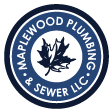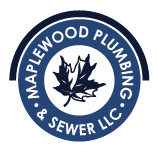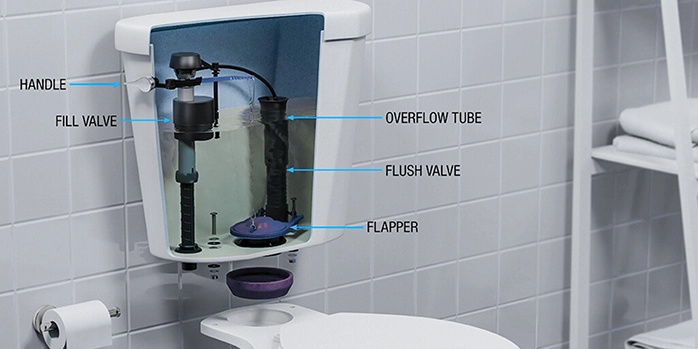
We use them multiple times a day, but most of us rarely think about the engineering behind our toilets — until something goes wrong. Whether you’re dealing with a running toilet, weak flush, or just want to understand how your plumbing works, keep reading as we break down each part and how they work together to keep things flowing smoothly.
Getting to the Bottom of It: Understanding How the Parts of Your Toilet Work
Bowl & Rim
The most visible part of any toilet is the bowl. Toilet bowls come in different shapes, like round, elongated, or compact, depending on the toilet style and size. Sitting atop the bowl is the rim. The rim has many small holes under the lip that allow water to flow into the bowl during a flush, rinsing the sides of the bowl. The rim and bowl are usually made of durable, easy-to-clean porcelain.
Toilet Seat & Lid
Attached to the bowl via hinges is the toilet seat and lid. The seat is the round part you sit on, while the lid covers the seat. They are usually made of either plastic or wood. The seat and lid don’t play a role in the toilet’s operation, but they do provide comfort and cleanliness.
Toilet Tank
Behind the bowl rises the tank, the tall rectangular box that holds the water for each flush. The tank is typically made of porcelain to match the bowl. It usually holds around 2 gallons of water, but low-flow and dual-flush toilets may have different tank sizes. A removable tank lid covers the top of the tank. The lid allows access to the inner workings of the tank for maintenance. Some more modern toilets conceal the tank inside the wall.
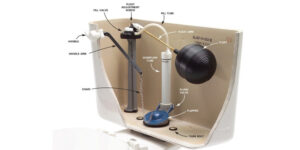
Fill Valve & Tube
Inside the tank, the fill valve and tube are responsible for refilling the tank with fresh water after each flush. The fill valve is connected to the water supply line. When the tank is empty, the fill valve opens, letting water flow into the tank. The fill valve is attached to an adjustable float that rises with the water level. When the float reaches the proper height, it closes the fill valve, stopping the water flow. A small flexible fill tube connects the fill valve to the overflow tube, refilling the bowl after a flush.
Flush Valve
The flush valve sits at the center of the tank bottom, covered by a flapper or tank ball. It is the main drainage point for water leaving the tank into the bowl. When flushed, water flows from the tank through the flush valve opening into the bowl below.
Flapper/Tank Ball
The flapper or tank ball is the “plug” that sits on top of the flush valve, holding the water in the tank between flushes. Flappers are made of flexible rubber and form a seal around the flush valve opening. Older toilets use a tank ball, which looks like a balloon or ball attached to a rod. When you push the flush lever, the flapper or ball is lifted up, allowing water to rush through the flush valve into the bowl, starting the flushing action. As the tank empties, the flapper or ball falls back onto the flush valve opening, sealing it for the next flush.
Flush Lever & Chain
The flush lever, usually located on the outside of the tank, is the handle or button you press to start a flush. When pressed, the flush lever pulls the chain attached to the flapper or tank ball, lifting it off the flush valve and allowing water to enter the bowl.
Overflow Tube
The overflow tube is a safety feature that prevents the tank from overflowing with water. It’s a tall plastic or metal tube near the center of the tank. If the fill valve malfunctions and doesn’t stop water from entering the tank, the excess water will spill over the top of the overflow tube and harmlessly enter the bowl, avoiding messy overflows onto your floor. The small tube coming from the fill valve also aims water down the overflow tube to refill the bowl after a flush.
Toilet Trapway
When the water from the tank rushes into the bowl, it flows through the toilet trapway, the S-shaped pipe at the back of the toilet. The trapway has a twisting, curving shape to allow waste and paper to pass through while keeping sewer gases from entering your bathroom. The water flowing through the trapway creates a siphon effect that sucks waste and paper out of the bowl into the drainpipe. After the flush, a small amount of water remains in the curve of the trapway, acting as an air seal against sewer odors.
Wax Ring
Hidden underneath your toilet, connecting it to the drainpipe in the floor, is the wax ring. This thick ring of sticky wax forms a watertight, airtight seal between the toilet’s drain opening (called the horn) and the drainpipe. This seal prevents leaks and keeps sewer gases from seeping out from around the toilet base. When installing a new toilet, it’s crucial to use a fresh wax ring to ensure a proper seal.
Your Toilet’s Operation, Explained
Now that we’ve examined all the key parts of a toilet, let’s discuss how they work together:
- You press the flush lever, which pulls the chain and lifts the flapper off the flush valve.
- Water flows from the tank through the flush valve into the bowl.
- Water rushing into the bowl flows through the rim holes, rinsing the bowl sides.
- The power of the water flow creates a siphoning action in the trapway, sucking waste and paper out of the bowl and sending it down the drainpipe.
- The flapper falls back onto the flush valve, sealing off the tank, while the fill valve opens, refilling the tank.
- The small fill tube sends a little water down the overflow tube into the bowl, replenishing the standing water in the trapway.
- When the tank reaches the set water level, the float closes the fill valve, and the toilet is ready for the next use.
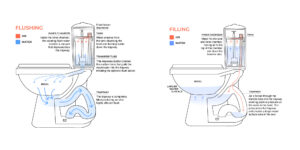
Troubleshooting Different Toilet Parts: Common Issues & How to Fix Them
While modern toilets are quite reliable, issues can sometimes arise with different toilet parts. Here are some common problems you might encounter and how to address them:
Toilet Keeps Running
One of the most frequent issues homeowners face is a toilet that continues to run long after flushing. This usually points to one of two underlying causes. The primary culprit is typically a deteriorating flapper – the rubber seal that controls water flow from the tank to the bowl. As this component ages, it can lose its ability to create a proper seal, allowing water to constantly trickle into the bowl. Fortunately, replacing a flapper is a straightforward fix: simply turn off the water, drain the tank, remove the old flapper, and install a new one, making sure it creates a tight seal over the flush valve opening.
The second possible cause is an improperly adjusted float. When the float sits too high, water can continuously spill into the overflow tube. To resolve this, locate the fill line marked inside your tank and adjust the float height until the water stops at this level.
Weak, Incomplete Flushes
When your toilet’s flush seems less powerful than usual, the issue often stems from two potential sources. Mineral buildup and debris can accumulate in the rim holes around the bowl’s edge, restricting water flow. These holes can be cleared by carefully scrubbing them with a small brush. Additionally, check that your flapper is lifting completely during each flush and that the chain has enough slack to allow full movement – but not so much that it gets caught under the flapper.
Clogs & Backups
Clogs develop when waste or foreign objects become lodged in the trapway, drainpipe, or sewer line. For minor blockages, your first line of defense should be a flange plunger. To use it effectively, ensure there’s enough water in the bowl to cover the plunger’s head, position it directly over the drain hole, and pump it several times to create the pressure needed to dislodge the clog.
For more stubborn blockages, a toilet auger can be remarkably effective. This specialized tool features a cable that you feed into the bowl while turning the handle, allowing it to navigate through the trapway and break up more resistant clogs.
Phantom Flushes
If your toilet seems to flush by itself periodically, you’re experiencing what plumbers call “phantom flushes.” This mysterious occurrence usually indicates a slowly leaking flapper. As water gradually seeps from the tank into the bowl, the fill valve activates to replenish the tank, creating what sounds like a spontaneous flush. Installing a new flapper typically resolves this ghostly phenomenon.
Leaks Around the Base
When you notice water pooling around your toilet’s base, this signals a failing wax ring seal between the toilet and the floor flange. Addressing this requires more involved work: shut off the water supply, drain both the tank and bowl, and disconnect the toilet from the floor. After removing the old wax ring, install a fresh one before remounting the toilet (this is also a good time to inspect your subfloor for any water damage that might need attention.)
Let Us Handle the Hard Part of Toilet Repair
Understanding the different parts of your toilet and how they work is invaluable for any homeowner. While this knowledge can help you diagnose issues and tackle minor repairs, let’s be honest — toilet repairs aren’t exactly anyone’s idea of a fun weekend project. That’s where calling a professional plumbing company comes in.
Contact us today, and we’ll take care of your toilet plumbing needs while you focus on more enjoyable aspects of homeownership. After all, some things are better left to the experts.
Comments are closed
